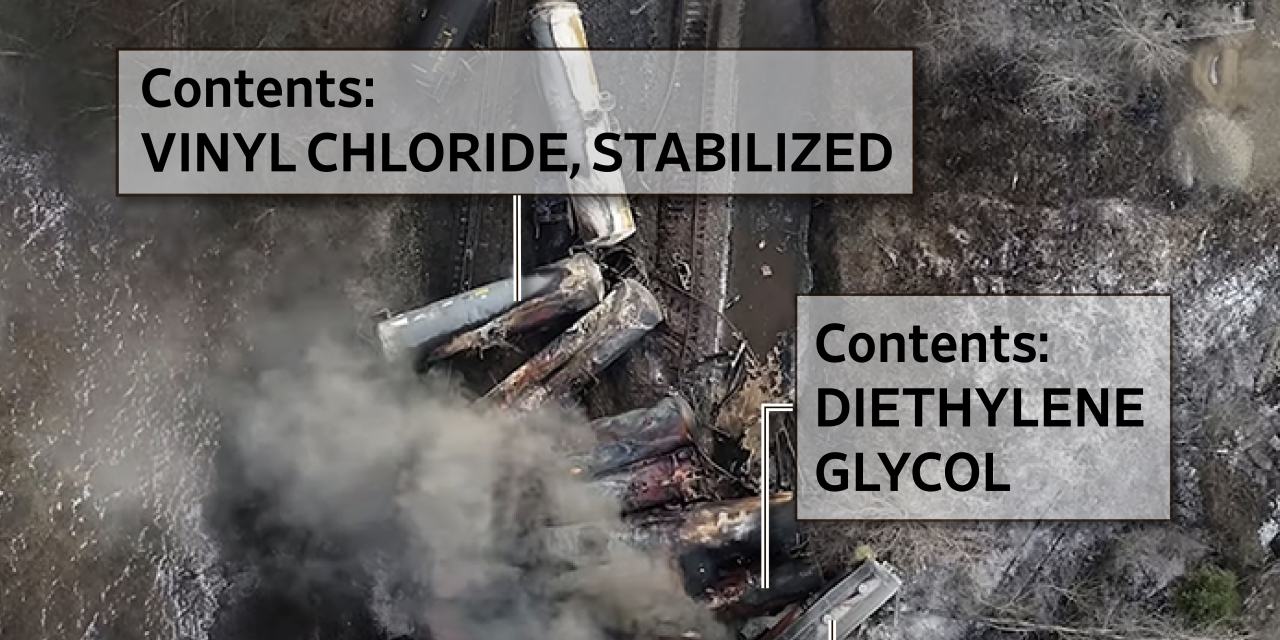Ohio Train Derailment: Persistence Of Toxic Chemicals In Buildings

Table of Contents
Pathways of Chemical Contamination
The release of toxic chemicals from the derailed train in East Palestine created multiple pathways for contamination of nearby buildings. These pathways necessitate a multi-pronged approach to remediation and highlight the complexities of addressing this environmental disaster.
Airborne Dispersion
Volatile organic compounds (VOCs), such as vinyl chloride, released during the derailment and subsequent controlled burn, spread through the air and infiltrated buildings.
- VOC Infiltration: The porous nature of many building materials – including wood, drywall, and even some paints – allowed VOCs to penetrate walls and settle on surfaces, potentially leading to long-term exposure.
- Harmful Chemicals: Vinyl chloride, a known carcinogen, and other toxic chemicals present in the derailed train's cargo, posed immediate and long-term health risks to residents.
- Air Purification Challenges: Complete air purification and remediation of affected buildings present significant challenges, especially given the pervasive nature of airborne contamination and the potential for re-emission of chemicals from building materials.
Surface Contamination
Chemicals also settled on both exterior and interior surfaces of buildings near the derailment site.
- Chemical Persistence: Vinyl chloride, for example, can persist on surfaces like vinyl siding, while other chemicals like butyl acrylate may adhere to carpets and fabrics.
- Leaching and Secondary Contamination: Persistent chemicals can leach from contaminated surfaces over time, leading to secondary contamination of indoor air and potentially contaminating other surfaces or objects within the home.
- Decontamination Challenges: Effective surface decontamination requires specialized cleaning techniques and potentially the removal of heavily contaminated materials, presenting a significant and expensive remediation challenge.
Groundwater and Soil Contamination
The derailment significantly impacted groundwater and soil in the vicinity, creating a pathway for contamination of building foundations.
- Vapor Intrusion: Contaminated soil can release VOCs into buildings through vapor intrusion, leading to indoor air contamination.
- Well Water Contamination: Groundwater contamination poses risks to residents relying on well water for drinking and other domestic uses.
- Soil and Groundwater Remediation: The long-term remediation of soil and groundwater contamination is complex and expensive, often requiring extensive excavation, treatment, and monitoring.
Health Impacts of Persistent Chemicals
Exposure to toxic chemicals released during the Ohio train derailment poses significant health risks to residents, both acutely and in the long term.
Acute Health Effects
Many residents reported experiencing a range of acute health effects immediately following the derailment.
- Reported Symptoms: Symptoms included headaches, nausea, vomiting, respiratory irritation, and skin rashes.
- Documented Cases: Reports and studies on the immediate health effects are crucial for understanding the short-term impacts of exposure.
Long-Term Health Risks
Continued low-level exposure to persistent toxic chemicals can have severe long-term consequences.
- Carcinogenic Properties: Some of the chemicals released, such as vinyl chloride, are known carcinogens, increasing the risk of cancer.
- Neurological and Reproductive Issues: Exposure to certain chemicals may also lead to neurological disorders, reproductive problems, and other chronic health conditions.
- Long-Term Monitoring: Long-term health monitoring and epidemiological studies are essential to fully assess the long-term health impacts on the affected community.
Remediation and Mitigation Strategies
Addressing the persistence of toxic chemicals in buildings requires comprehensive remediation and mitigation strategies.
Building Remediation Techniques
Cleaning and decontaminating affected buildings necessitate various techniques.
- Air Filtration and Purification: High-efficiency air filtration systems are needed to remove VOCs from the indoor air.
- Surface Cleaning and Decontamination: Specialized cleaning procedures, potentially involving chemical treatments or removal of affected materials, are required for surface decontamination.
- Specialized Equipment and Protective Gear: Remediation efforts necessitate the use of appropriate equipment and personal protective equipment to ensure the safety of workers and prevent further contamination.
Long-Term Monitoring and Surveillance
Ongoing monitoring is crucial to ensure the effectiveness of remediation efforts and assess the long-term persistence of chemicals.
- Environmental Monitoring: Regular monitoring of air, water, and soil quality is crucial for detecting any lingering contamination.
- Health Surveillance: Continued health surveillance of residents is necessary to track potential long-term health effects and guide appropriate medical interventions.
Conclusion
The Ohio train derailment's impact extends far beyond the immediate aftermath. The persistence of toxic chemicals in buildings near the crash site poses significant long-term health and environmental risks. Understanding the pathways of contamination, the associated health impacts, and the necessary remediation strategies is crucial. The situation underscores the need for comprehensive action, including thorough building remediation, ongoing environmental monitoring, and long-term health surveillance for affected residents. Understanding the persistence of toxic chemicals in buildings after the Ohio train derailment is crucial for effective remediation and preventing future tragedies. Stay informed, demand action, and help ensure the safety of our communities. Continued vigilance and proactive measures are necessary to mitigate the lasting effects of this environmental disaster and prevent similar incidents in the future.

Featured Posts
-
 Dakota Johnson Melanie Griffith And Siblings Attend Materialist Screening
May 10, 2025
Dakota Johnson Melanie Griffith And Siblings Attend Materialist Screening
May 10, 2025 -
 2025 82000
May 10, 2025
2025 82000
May 10, 2025 -
 Analyzing The Relationship Between Dangote And Nnpc Petrol Prices
May 10, 2025
Analyzing The Relationship Between Dangote And Nnpc Petrol Prices
May 10, 2025 -
 Instagram Vs Tik Tok Ceos Testimony Highlights Fierce Competition
May 10, 2025
Instagram Vs Tik Tok Ceos Testimony Highlights Fierce Competition
May 10, 2025 -
 Investigating Us Funding For Transgender Animal Research Studies
May 10, 2025
Investigating Us Funding For Transgender Animal Research Studies
May 10, 2025
